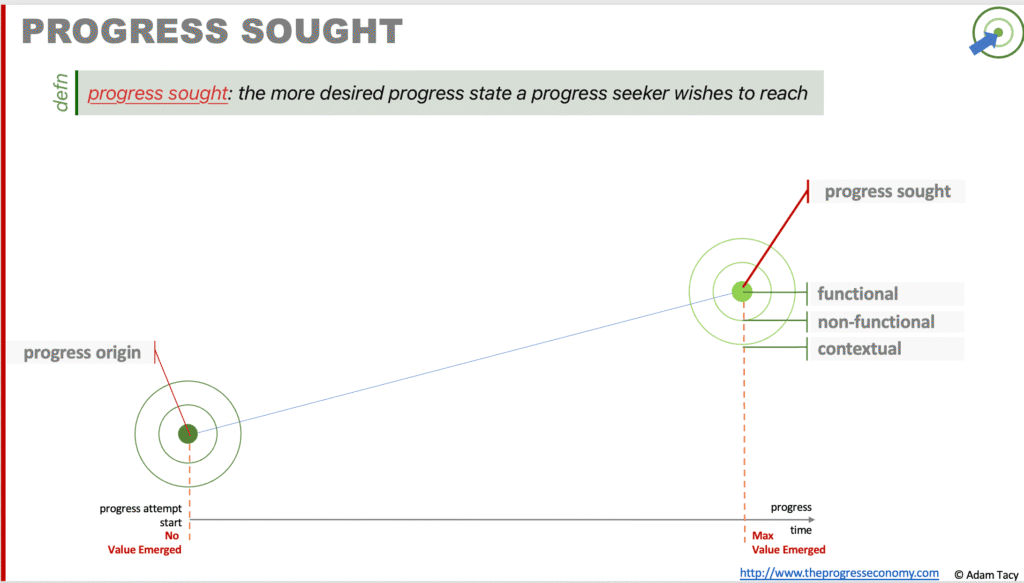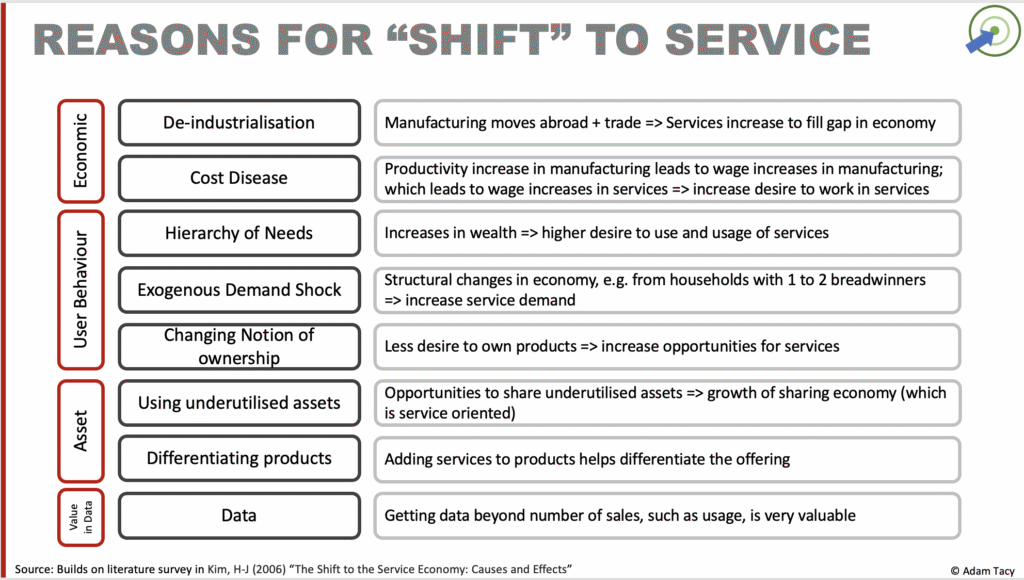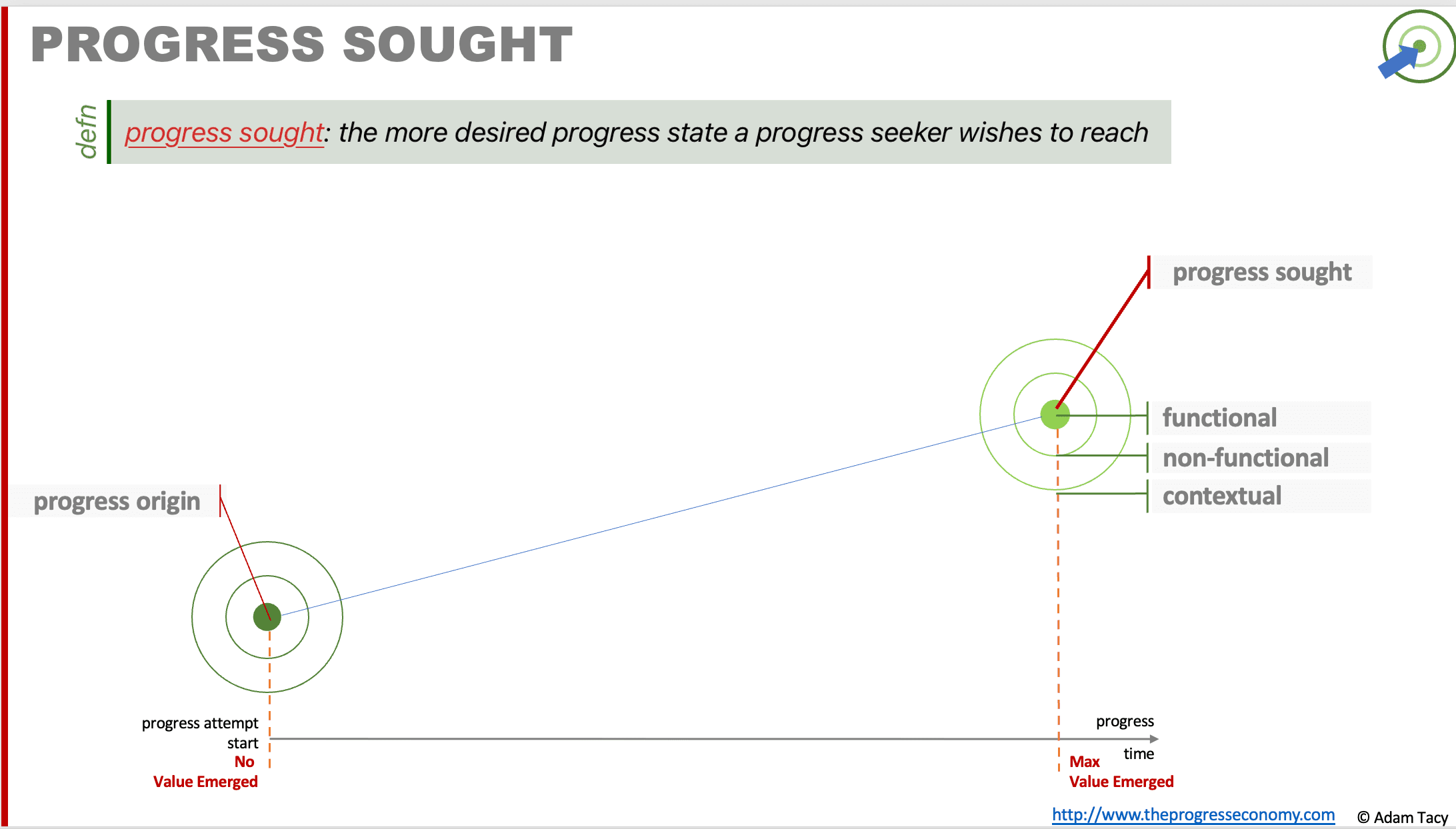What we’re thinking
Progress sought is the more desirable progress state – capturing functional, non-functional, and contextual elements – that a progress seeker wishes to reach. Upon reaching progress sought, the seeker likely recognises maximum value.
It complements progress origin, giving us a fuller picture of a seeker’s journey and the gaps towards that. It also has a strong relationship with a progress proposition’s progress offered.
We should be aware that there are three main external influences on a Seekers progress sought:
- externalities – such as governments, industry bodies etc – they may insert mandatory aspects of progress sought
- it naturally evolves over time as Seekers gain resources (skills, knowledge, tools, etc) from other attempts in your own and other markets and industries
- new resources open up new and/or better progress sought
Understanding a Seeker’s progress sought is fundamental to creating and evolving progress propositions, better segmenting markets, sales, and innovating.
- Sales should seek to understand a Seeker’s progress sought and help them see how close a proposition’s progress offered is (including performing any customisation or lining to other propositions that get a Seeker further).
- Innovation’s goal should be to create new propositions that align closer to individual Seeker’s progress sought whilst minimising equitable exchange progress hurdle.
Progress sought
The driving thought behind the progress economy is that we are all trying to make progress in everything we do. And by progress I mean:
progress: moving over time to a more desirable state
where that more desirable state is something we call: progress sought.
progress sought: the more desired progress state a progress seeker wishes to reach
This is one of a number of named progress states which, as usual, consists of three elements. These elements reflect the desired state:
- functional – the outcome of an action
- non-functional – soft attributes, such as “felt safe”, “gained a sense of achievement”, etc
- contextual – constraints a progress attempt operates within

It captures the desired destination in a progress attempt. Together with a seeker’s progress origin, progress sought provides depth of understanding of the progress journey a seeker wishes to attempt as well as the challenges they may face along the way.
Capturing it adds depth to understanding a seeker’s progress journey from their progress origin (the starting progress state of their current progress attempt) as well as the gaps they have in reaching this progress sought.

A seeker’s progress sought
A seeker’s progress sought captures their desired progress state they wish to move to in their current progress attempt. If learning a language is their progress journey, then progress sought would capture their desired proficiency (as well as any desired non-functional and contextual elements).
Other examples of functional progress sought are feeling nourished, have moved to a new location, have fixed something, built something, enjoyed oneself, and much more. Whereas examples of non-functional progress are achieved self actualisation, felt rewarded, had sensory appeal; and contextual progress is the constraints, like in the above example where there is a struggle to find consistent time to learn (implying regular classroom sessions is not an optimal offering).
Compared to progress origin, there is only a Seeker’s view of progress sought. The dual of a proposition’s progress origin we call progress offered.
Getting practical
Philosophically, progress sought covers everything in a seeker’s life that they are seeking to move to a more desirable state.
However we see overall progress sought to consist of a number of well-defined, specific, aspects. And, for practical reasons, we usually restrict ourselves to consider one aspect of that progress sought at a time. The exception being if we want to understand why a seeker choses to make one progress attempt over another.
An initially odd aspect of progress sought is the dealing with externalities.
The affect of externalities
Whilst there is only one progress sought in the progress economy – the seeker’s view – that can be affected by the influence of externalities – like governments, regulators, associations, and society as a whole.
By this I mean that an externality can inject progress sought with its own desirable state. Often the aim of these is to prevent/minimise negative impacts on seekers and society. And the progress they insert is often enacted by legislation or similar regulations. They might, for example, require:
- qualifications for those performing progress-making activities – working on gas appliances demands a certified engineer; or medical-related progress requires qualified doctor or nurses
- safety designs/controls for resources used – motor vehicles must have three point seatbelts
- mandated learning – like defining curriculum in schools
Sometimes, inserted progress by externalities is their to encourage seekers to take specific actions. Here in Sweden, and other countries, the government actively promotes sustainability by implementing a deposit scheme on plastic bottles. Seekers pay a small deposit on a plastic bottle, which they can get back by returning the bottle for recycling. The ability to recycle is inserted into seekers’ progress sought.
You might wonder why I include these as part of progress sought rather than progress offered (the state that a proposition offers to help reach). It comes down to our perspective on progress, where seekers are primary striving to make progress and may engage a helper if needed. It makes sense then that externalities insert into progress sought.
Relating to Value
Value in the progress economy is a set of progress comparisons, predominantly made by the Seeker. At the Seeker’s progress ought there is only the Seeker’s judgement of emerged value to be concerned with:
- Emerged value: the Seeker’s judgement of progress reached vs their progress sought
It is natural to now believe that maximum value has emerged since progress reached is the same as progress sought. Similarly, we can believe that all that emerged value is now also recognised by the Seeker (making it meaningful to them).

Now, we have to be aware that progress sought evolves over time (and even during a progress journey). This has implications for value judgements. The longer the journey to reach progress sought, or longer length progress-making activities, the higher the risk that a Seeker’s original progress sought has changed. Therefore progress comparisons lead to lower judgements of value (progress reached is now further away from progress sought) and perhaps abandoned journeys.
That topic is for when we discuss progress as a verb/progress attempts. Though below we look at what encourages progress sought to evolve over time.
Progress sought evolves over time due to…
As the saying goes:
No plan survives contact with the enemy.
Helmuth von Moltke the Elder, 1871
A Seeker’s progress sought tends to evolve over time, due to several factors:
- experience
- influences
- changing circumstances
Let’s briefly consider each of these.
Experiences
I’ve mentioned that for practical reasons we typically consider individual aspects of progress sought at a time. Here’s an example where we think more of the totality. Seeker’s are making progress attempts across many markets and industries. From each of those they are learning; and those learning lead to them rethinking their progress sought in other attempts. It is unlikely they are reducing their expectations!
Influences
It’s not just experiences they gain that can make Seekers evolve their progress sought. They are also exposed to various sources of information from different markets, industries, and the experiences of others. Friends, family, influencers, marketing, and online content all shape their views of what progress sought is possible. This can be seen as the process of innovation diffusion.
Changing circumstances
Another influence on progress sought evolving is that of changing circumstances (contextual progress). You may have heard of “the shift to the service economy”, where economies (you and I) move away from goods towards services (having previously moved from agriculture to goods).
In the progress economy this “shift” doesn’t really make sense since we don’t consider goods and service as different (for us, goods enable service to be transported in time and space…is there any difference between a bottle of water and a(goods) and water from the tap/faucet (services)?).
This shift then is really a change in the progress resource mix from one being predominately made of goods/physical resources to one predominantly of employees (incl AI)/systems. Or, in the lens of the progress proposition continuum, from enabling to relieving propositions.
The underlying reasons though are the same, and a level to explore for innovation. Here I group them into 4 categories: Economic, User Behaviour, Assets, and Value in Data.

It is tempting, and a strong narrative in the “goods economy” to believe this shift is one way. But it can go both ways, for good reasons. For instance, an increasing number of my friends are cultivating their own vegetables; shifting from relieving propositions of farms and supermarkets to more enabling propositions (seed shops, gardening tools etc).
And this change can happen quite rapidly. This is an interesting article on the fall of non-fungible tokens.
Relating to Sales
If you don’t know the more desirable state a Seeker is trying to reach, then sales will be extremely challenging for you. Whilst this is more a topic for progress offered, you need to be able to determine a Seeker’s progress sought, and track as it changes. This implies a continuing dialogue is usually necessary.
For progress sought that is simple, which generally leads to very short progress journeys and limited change to the original progress sought, your proposition becomes more commoditised. That is, the dialogic needs for each journey reduces. For example, the progress sought of “join to pieces of wood together” has not changed much over the centuries…and a nail together with a hammer are still valid propositions.
Relating to innovation
Innovation should focus on getting a seeker closer to their progress sought, which again is more a topic for progress offered. Here, I just repeat the comment from sales: you need other know Seeker’s progress sought before you can realistically innovate to get them closer to that.
There is a final observation we can make: the constant evolution of progress sought is the driving force of innovation both for a Seeker progressing on their own and for helpers’ progress offered.

Let’s progress together through discussion…